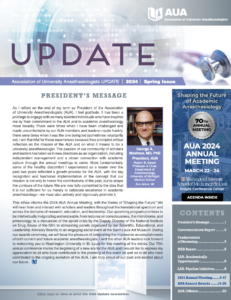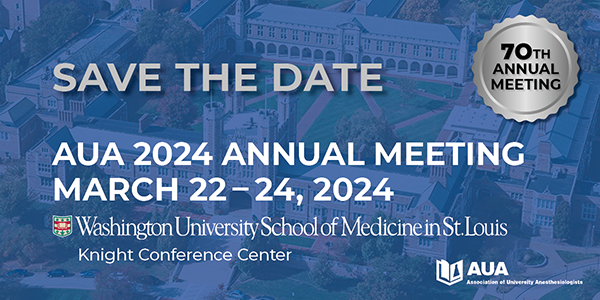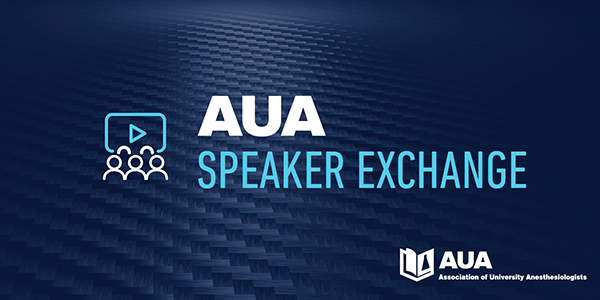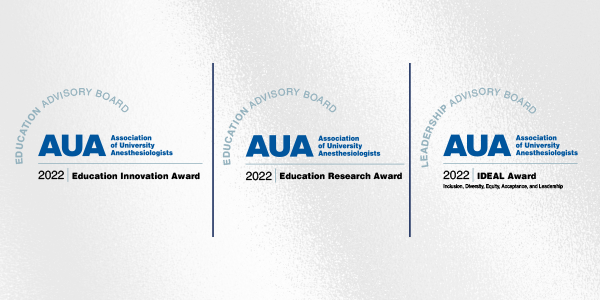SAB Report – AUA Symposium: Anesthesia and Consciousness
Anesthesia and Consciousness: How Investigations of the Anesthetized State Shape Current Concepts of Consciousness
Moderated by Ines P. Koerner, MD, PhD, Oregon Health & Science University, AUA Education Chair
Once again, AUA sponsored a science-focused, well-attended symposium at the IARS annual meeting. This year’s symposium “Anesthesia and Consciousness”, which was presented in Montreal on May 18, 2019, brought together an outstanding panel of experts to discuss how investigations of the anesthetized state inform our understanding of the nature and substance of consciousness. Audience members were treated to reviews of the cortical correlates of consciousness and of sensory awareness, learned about the neurobiology of arousal, and were introduced to the use of network motifs to assess awareness in disorders of consciousness.
The Controversial Correlates of Consciousness
George A. Mashour, MD, PhD, University of Michigan Medicine
George Mashour, Professor of Anesthesiology, Neurosurgery and Psychology and Founding Director of the Center for Consciousness Research at the University of Michigan, began the symposium with a discussion of the neural correlates of consciousness. He reviewed the current understanding that an anterior cortical network ignites the conscious brain, while anesthetics inhibit the functional connectivity between frontal and parietal brain regions. Dr. Mashour’s group uses reverse microdialysis of cholinergic agents to probe the contribution of cholinergic pathways to consciousness and arousal. Acetylcholine levels are reduced in both the prefrontal and posterior parietal cortex during sevoflurane anesthesia. Introducing the mixed cholinergic agonist carbachol into the prefrontal cortex of rats anesthetized with 1 MAC sevoflurane increases cerebral acetylcholine levels and recovers the animals’ righting reflex (a measure of arousal), while carbachol does not have the same effect when introduced into the posterior parietal cortex. Systemic application of a sub-anesthetic dose of ketamine during isoflurane general anesthesia increases acetylcholine levels in the prefrontal and paradoxically accelerates emergence from anesthesia, as defined by return of righting reflex, despite more animals achieving an EEG burst suppression pattern, which further supports that cholinergic transmission in the prefrontal cortex facilitates emergence from anesthesia.
Consciousness, Sensory Disconnection and Anesthesia
Robert Sanders, MBBS, PhD, FRCA, University of Wisconsin School of Medicine and Public Health
Dr. Robert Sanders, Assistant Professor of Anesthesiology at the University of Wisconsin, next discussed sensory disconnection and awareness. He defined disconnected consciousness, or sensory disconnection, as a state of conscious experience that is not driven by the external world, as is experienced during dreaming. Dr. Sanders emphasized that unresponsiveness during anesthesia is not necessarily equivalent to unconsciousness, but rather may represent sensory disconnection. He suggested that disconnected consciousness, i.e. dreaming, may be acceptable during general anesthesia as long as there is no awareness of the patient’s surroundings. Interestingly, patients may not necessarily expect complete lack of awareness during general anesthesia, as long as they do not remember: While 96% of survey respondents expected to be unconscious during general anesthesia, about 40% would accept awareness if there were no recall later. Dr. Sanders employs the isolated forearm technique to assess awareness during general anesthesia. This technique uses a tourniquet to prevent neuromuscular blockade of a forearm during a balanced general anesthesia and then asks the patient to squeeze the examiner’s hand while anesthetized and indicate whether they experience pain. Dr. Sanders’ work suggests that episodes of awareness without recall may happen in up to 5 – 35% of general anesthetics while 6% of patients in this highly controlled setting can recall being asked to do things while anesthetized. In contrast, spontaneous occurrence of awareness with recall after anesthesia is much less frequent, affecting only 0.1 – 0.2% of all general anesthesia cases. Current monitoring techniques are not able to reliably detect awareness or predict recall. The anesthetized state e.g. during propofol anesthesia is reliably characterized by a frontal alpha/delta EEG pattern, yet awareness can at times be detected using the isolated forearm technique when this pattern is present. A better understanding of the anesthetized state and the role of sensory disconnection is thus necessary to present awareness. Dr. Sanders’ group is working to identify techniques that can differentiate sensory disconnection from unconsciousness. EEG response to transcranial magnetic stimulation (TMS) appears a promising tool, as TMS-evoked alpha activity is reduced in states of sensory disconnection.
A recurrent theme of the symposium, emphasized by both Drs. Mashour and Sanders, was the importance of differentiating the content of consciousness, i.e. the conscious processing of one’s self and surroundings, and the ability to reflect on them, from the level of consciousness, i.e. the ability to be aware. The latter is more easily investigated, including in animal studies, and is a prerequisite for the former, while the former may be the more clinically important endpoint.
Subcortical Arousal Systems and Emergence from General Anesthesia
Ken Solt, MD, Harvard Medical School; Massachusetts General Hospital
The third speaker Dr. Ken Solt, Associate Professor of Anesthesia at Harvard, focused on the distinct role of subcortical arousal systems for emergence from anesthesia. Dr. Solt first reviewed subcortical arousal pathways and their neurotransmitters, such as dopamine, serotonin, histamine, acetylcholine, orexin, and norepinephrine and shared data suggesting that mechanisms of arousal may be specific to the anesthetic agent involved. Tapping into these arousal pathways, Dr. Solt’s group is testing an array of currently available drugs for their potential as anesthesia reversal agents. He shared promising pre-clinical data using methylphenidate (Ritalin), which enhances subcortical arousal pathways by blocking reuptake of dopamine and norepinephrine, to accelerate emergence from general anesthesia. Surprisingly, this finding was not reproduced in the group’s recently completed phase II clinical trial, in which intravenous application of methylphenidate towards the end of a balanced general anesthetic for prostatectomy did not reduce time to extubation. Dr. Solt discussed possible explanations related to dosing or timing of drug application, or to confounding effects of a balanced anesthetic as opposed to the sevoflurane monotherapy used in preclinical studies. Arousal pathways appear specific to the anesthetic agent, as for example dextroamphetamine, a potent enhancer of adrenergic and dopaminergic pathways, can reverse sedation by dexmedetomidine, but not ketamine.
Using Anesthesia to Probe Disorders of Consciousness
Stefanie Blain-Moraes, PhD, McGill University
Finally, Dr. Stefanie Blain-Moraes, Assistant Professor at the School of Physical and Occupational Therapy at McGill University discussed how anesthesia can be used to study disorders of consciousness. Remnants of consciousness can be detected by functional MRI and EEG in patients with unresponsive wakefulness syndrome (UWS), with some awareness being present in up to 40% of patients examined. To aid in identifying patients that may have retained consciousness, Dr. Blain-Moraes developed a high-intensity EEG study protocol that assesses network motifs during induction of anesthesia and emergence from the anesthetic state. Dissecting the topography of network motifs observed during loss and return of consciousness in healthy individuals and those with disorders of consciousness, she was able to identify characteristic motifs that, when preserved in patients with disorders of consciousness, may predict remnants of consciousness and possibly recovery. Her report highlighted a patient who, despite being diagnosed with UWS retained some normal motifs during anesthesia induction, and started to interact with the environment in the weeks following the study.
There was rich discussion in the Q & A session, pondering questions such as whether traditional frontal EEG monitoring can be considered valid, whether there are different qualities of burst suppression, philosophical reflections on whether emergence from anesthesia or restoration of the righting reflex are equivalents of consciousness, and how the return of executive function can be modeled in animals. Similarly, there was discussion on the difference between states of altered consciousness and the limitations of data derived from the anesthetized state, as the affected pathways are so specific to the anesthetic agent. The use of network motif analysis to predict prognosis in coma is a very exciting new therapeutic possibility. Participants left the symposium looking forward to future updates on these exciting topics.











